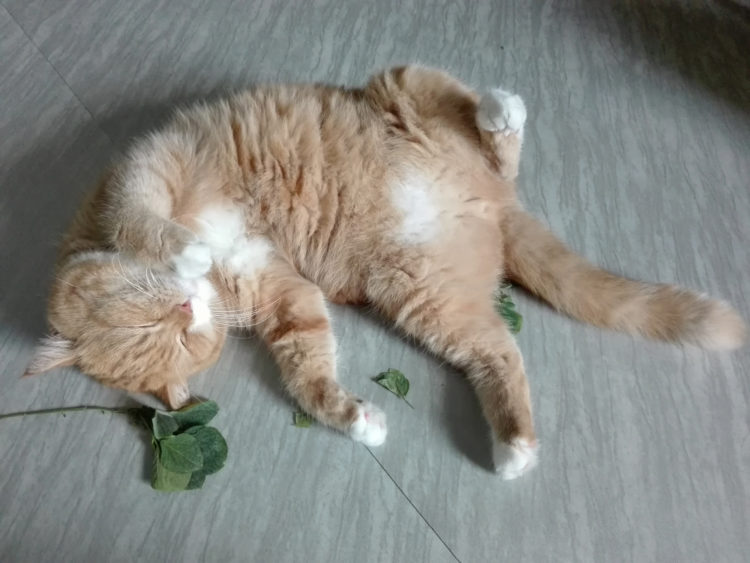As cat lovers, I think we can all agree—there’s nothing more delightful and entertaining than watching our cats go bananas over catnip.
But did you know how simple it is to grow catnip and harvest the plant yourself?
When it comes to gardening, catnip is basically foolproof. Plus, this hardy plant boasts a number of health benefits for both cats and humans. Reason enough for any beginner gardener to try their hand at growing it.
I like to keep a stash of catnip handy in my freezer. Throughout the summer, I’ll harvest it and dry it out to preserve it, so I can take advantage of its benefits year-round.
Benefits of Catnip:

- Reduces Stress: catnip’s sedative properties ease anxiety and depression in cats, making it especially valuable in high-stress shelters.
- Calms Upset Tummies: catnip relaxes tense stomach muscles, minimizing bloating and flatulence.
- Makes Bath Time Fun: Most cats don’t love the water, but add a little “catnip tea,” and they may actually enjoy bath time. A catnip-infused bath can also soothe your cat’s irritated skin.
- Encourages Playtime: Sprinkle dried catnip on scratching posts or toys to coax your cat into using them.
- Humans Can Use It Too: Catnip tea can soothe an upset stomach, alleviate nerves, and treat insomnia.
Convinced you need to start growing catnip? Here’s how to do it.
Container Planting Vs. In Ground Planting
First, decide if you want to grow your catnip directly in your outdoor garden or in containers. If you’re planting outside, you can plant seeds in the spring, after the threat of frost has passed. Opting for container gardening? You have your choice of spring or fall planting.
Pro Tip: One benefit to growing catnip in containers—this audacious plant tends to overtake gardens. Limiting it to a container will keep the catnip from spreading too aggressively.
Space seeds 18-24 inches apart, ⅛ of an inch below the soil. Seeds should sprout in 10-20 days. (Always an exciting event, no matter how many times I’ve seen it happen!)
Give Your Catnip Seedlings Proper Water and Sunlight
 Water your seedlings well as they germinate. The soil must stay moist until the green seedlings appear above the soil.
Water your seedlings well as they germinate. The soil must stay moist until the green seedlings appear above the soil.
Make sure your indoor container is positioned where it will get enough sunlight—around six hours per day ought to do it. Catnip prefers full sun, although you can still grow it in partial shade (it will just be smaller).
Bring Your Catnip Seedlings Outside
Once frost is no longer a threat, you can bring your catnip plant outdoors where it will be more likely to thrive. At first, your plant will be thin, but be patient—as it acclimates to the outdoors, it will grow hardier and fuller.
Even through catnip prefers to grow outdoors, you can still successfully cultivate this plant indoors on a sunny windowsill, if you prefer.
Reduce Watering
Initially, you’ll need to water your outdoor catnip plant frequently. After the plant has adjusted to its new environment, you can reduce watering to once a week (or twice a week in partial sun areas).
Catnip is hardy and drought-resistant, so once the plant is established let the soil dry in-between waterings.
Maintain Your Plant
Maintain your catnip plant by regularly removing dead or dried leaves. Cut whole stems down to use or dry and save for later. This will encourage new growth.
You won’t need to worry about fertilizing or feeding your catnip plant (another selling point for amateur gardeners!) Aside from roaming neighborhood strays, you also won’t need to worry about rodents or insects harming this sturdy plant.
Protect your catnip from overly excited kitties with chicken wire or fencing. Consider staking smooth bamboo shoots to support the plant and discourage cats from rolling in it.
It’s Harvest Time!
 The best time to harvest your catnip is midsummer, when the plant is flowering. Cut off whole stems, rather than single leaves, close to the base of the plant.
The best time to harvest your catnip is midsummer, when the plant is flowering. Cut off whole stems, rather than single leaves, close to the base of the plant.
You can preserve fresh catnip in the fridge, but it will only last a few days. Or you can dry your harvested leaves to use later, although it won’t be as potent as fresh catnip.
Place stems in a cool, dark area to dry completely. When they become crumbly to the touch, they are ready to store.
Separate the leaves from the stems. Crumble the leaves and place them in an airtight, plastic bag. Store catnip in a cool, dry place away from damaging sunlight or heat. A freezer will work to preserve dried catnip as well.
This hardy perennial is a must-have for any cat aficionado. Even if your cat isn’t enthused with the plant’s euphoria-inducing properties—it affects each feline differently—you can still use its leaves in a relaxing cup of tea. That more than deserves two (green) thumbs up!






